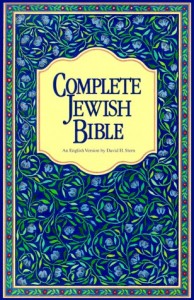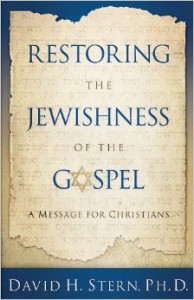 I’ve just finished reading Matthew’s Gospel in David H. Stern’s Complete Jewish Bible (CJB), “An English Version of the Tanakh (Old Testament) and B’Rit Hadashah (New Testament).” It’s quite fascinating.
I’ve just finished reading Matthew’s Gospel in David H. Stern’s Complete Jewish Bible (CJB), “An English Version of the Tanakh (Old Testament) and B’Rit Hadashah (New Testament).” It’s quite fascinating.
Stern’s translation philosophy stems from a Messianic Judaism which seeks to emphasise the unity of Scripture. That is to say that the whole Bible is Jewish. In my short experience of the CJB I have noted that Stern expresses this in two ways:
Firstly, in his choice of vocabulary. This is clearly evident in that Hebrew transliterations are used for the names of people. Jesus is Yeshua. Peter is Shi’mon, or Kefa etc.
On top of this, certain key words and phrases are not translated into English but into Hebrew words which are intended to not only provided connecting threads between the Testaments, but also (I assume) towards a contemporary Jewish framework.
Consider, for example, the rendering of the Great Commission with keywords used for disciples (talmidim) and the Holy Spirit (Ruach HaKodesh) and the more literal “immersing” rather than “baptising.”
Therefore, go and make people from all nations into talmidim, immersing them into the reality of the Father, the Son and the Ruach HaKodesh, and teaching them to obey everything that I have commanded you. (Matthew 28:19-20)
Secondly, there is a covenant centrism.
For instance, the word “Hosanna” in the Triumphal Entry is rendered according to its semantics of deliverance. The crowd’s cry as Yeshua enters Jerusalem is shown to be an exilic one, a longing for a new exodus. I’m not convinced by the break down of the sentence structure here, but the sentiment encapsulates a covenant cry:
The crowds ahead of him and behind shouted,
“Please! Deliver us!”
to the Son of David;
“Blessed is he who comes in the name of ADONAI!”
“You in the highest heaven! Please! Deliver us!” (Matthew 21:9)
A deep correlation between blessing and Torah is evident:
…and many people’s love will grow cold because of increased distance from Torah. (Matthew 24:12)
The Son of Man will send forth his angels, and they will collect out of his Kingdom all the things that cause people to sin and all the people who are far from Torah; (Matthew 13:41)
And in the “salt and light” exhortation of the Sermon on the Mount, the parallelism is exposed such that saltiness is applied to the Land (a clear covenant connection with the Promised Land) and the light extends that blessing to the whole world (covenantal blessedness that is a blessing…)
You are salt for the Land…. You are light for the world. (Matthew 5:13,14)
Finally, there is an eschatology that emphasises the gathering of the diaspora and the regeneration of the earth – a more grounded hope that stands against a modern tendency for escapism.
Yeshua said to them, “Yes. I tell you that in the regenerated world, when the Son of Man sits on his glorious throne, you who have followed me will also sit on twelve thrones and judge the twelve tribes of Isra’el. (Matthew 19:28)
He will send out his angels with a great shofar and they will gather together his chosen people from the four winds, from one end of heaven to the other (Matthew 24:31)
General thoughts: While there is a clear agenda in these translation choices (there always is!), for most of us it provides a positive de-hellenizing corrective. In my limited exposure I have certainly found it to be a refreshing and a deepening experience. I read Matthew using the Kindle version of the text. The vocabulary, together with understated chapter and verse markings, and a single-column layout, had me engaged in a way that I have not experienced for a long time.
I was introduced to the author and the text through a group of Christians who are drawing on Messianic Judaism as a means of enriching and expressing their faith. It is a worthy means.
There are also resonances with projects such as New Perspectives which seek to re-engage with the Jewish foundations of the New Testament. The CJB certainly aides in the push-back against the dilution of gospel to a mere assuaging-the-conscience-of-the-individual.
Here is a coherent re-engagement in the pages of Scripture with covenant community and grounded eschatological hope. Here also, I believe, are the anchor points for an effective contemporary apologia, which is my own ongoing passion. But more on that some other time.
 Given my appreciation of David Stern’s Complete Jewish Bible translation I was looking forward to a brisk read through his diminutive Restoring the Jewishness of the Gospel. I was a little disappointed.
Given my appreciation of David Stern’s Complete Jewish Bible translation I was looking forward to a brisk read through his diminutive Restoring the Jewishness of the Gospel. I was a little disappointed.


